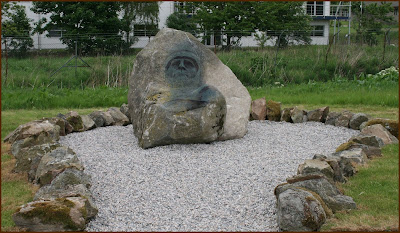As seen in an earlier post the
Comyns had prospered in the first three decades of the 13th century and
assumed a dominant position in Scottish affairs which would last until their
final defeat by Robert at Barra. http://barra1308.blogspot.com/2012/04/comyns-3.html
In
the coming years this dominance would be challenged by rivals, but the Comyn
party would work together to thwart the efforts of their various challengers.
When
William the Earl of Buchan died in 1233, his son Walter, Earl of Mentieth and
Lord of Badenoch, assumed the leadership and confronted the challenge from
their north eastern neighbors, the Bissets and the Durwards.
The
suspicious death of Patrick of Atholl in 1242, was the opportunity the Comyns
needed to attack their Bisset challengers who had been gaining more influence with the King (Alexander II). Walter and John Bisset were implicated in the death and
the Comyns, with the support of other nobles achieved the exile of the pair.
Fleeing to England the Bissets encouraged the interference of Henry III in the
affairs of Scotland, an unfortunate reality accepted by most in Scotland, but
which would lead to disaster before the end of the century.
At
the close of the reign of Alexander II, the Durwards rose to be the principle
advisers to the king, and on his sudden death they retained control during the
minority of Alexander III. The Comyns seized the young king and his queen taking
control of the government, forcing out the Durwards. The Durwards sought
Henry’s assistance, and again all were forced to accept his intervention. (It
should be noted that Alexanders queen was Henry’s daughter, and he did have
genuine concerns for her safety).
This
is the period in which the later chroniclers paint the Comyns as “over mighty
subjects”, but they were by then partisan Bruce/Stewart spin-doctors, and
sought to unfairly discredit the Comyns.
For
the remainder of Alexander III’s reign the Comyns were prominent in the affairs of
the realm, and on his untimely death were instrumental in stabilizing the situation
and provided two of the Guardians of the realm during the first interregnum.
(John II of Badenoch and Alexander Earl of Buchan).
Following
the death of Margaret, the heir to the throne, the Comyns supported the Balliol
claim, during the period of the “Great Cause”, in which Edward I was asked to
adjudicate the claimants to the throne,
However,
the Comyns also had a weak claim to the throne through Richard Comyn’s marriage
to Hextilda, the daughter of king Donald Ban. John II of Badenoch also had a
claim to the throne due to his marriage to Eleanor the sister of John Balliol,
but that claim would always be subservient to that of John Balliol and his descendants.
Edward
ruled in favor of John Balliol who became King of Scots, but Edward’s heavy-handed
approach eventually lead to war.
The
Comyns would consistently support the Scottish side during the war and John Comyn
III, co-led the Scottish victory at Roslin in 1303, but about a year later the Comyns
and the other Scottish magnates submitted to Edward, and it appeared the war
was finally over.
But,
two years later Robert the Bruce, murdered John Comyn, in Greyfriars church,
the pivotal event that led to Scottish independence and consigned the Comyns to
the historical dustbin.
Robert
after numerous setbacks, eventually crushed the Earl of Buchan at Barra, and
went on to totally destroy Comyn power.
It
is somewhat ironic that the Comyn family rose to power by crushing two campaigns,
launched from Moray, to seize the Scottish throne, but were themselves destroyed
by a third. Also, that the last senior male heir of the family, (John IV) who
had for a century defended the Scottish crown should be killed fighting on the
English side at Bannockburn.





















